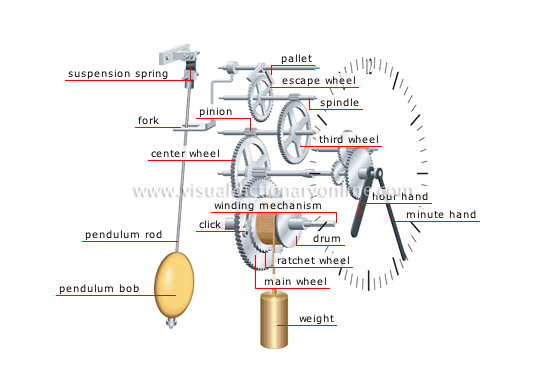Explaining to prospective clock customers, whether it is a shopper for a grandfather clock, or a wall clock, or a mantel clock, understanding the differences between weight-driven grandfather clocks and wall clocks in particular is critical to truly understanding clocks mechanisms, and being able to tell better quality clocks from more run of the mill clocks, whether looking at a new or antique grandfather clock or wall clock.
Weight-driven clocks by definition tend to be clocks with the most precision and best and reliable timekeeping. When comparing a spring driven grandfather clock or mantle clock or wall clock to a weight-driven model, in general there will be no comparison in terms of reliability, accuracy, and even longevity of movement. The one exception, sometimes found in the very best antique mantle clocks, is when looking at a fusee driven movement. The fusee movement was invented by none other than Leonardo DaVinci, and is designed especially to allow the movement to run at a highly precise and equal speed whether the clock is in its first or 8th day of operation, compared to a spring driven movement, where the tension varies much more over time. Relatively few clocks are made today with fusee driven mechanical movements, but some high-end makers do still produce them in small quantities. All other things being equal, which of course they rarely are, a fusee driven movement is highly desirable and collectible, especially for a mantel clock where there is practically speaking no room for a weight to descend anyway.
Mapping the parts of a mechanical movement is not easy to do well, yet we came across a wonderful diagram shown and credited below, which outlines the key parts of a weight driven movement.
weight-driven clock mechanism
This clock is operated by weights that, under gravity, drive the hands of the clock in their rotational movement by means of a gear train.
weight 
Heavy body that hangs from the main wheel; its descent provides the necessary energy for the clock’s mechanism.
ratchet wheel 
Toothed wheel having only one direction of rotation; it is kept in place by the click.
main wheel 
First wheel in the gear train that transmits the driving force of the weights to the other wheels to turn them.
click 
Small lever that is engaged between the ratchet-wheel teeth and prevents it from rotating counter to its normal direction.
pinion 
Small wheel with teeth that is mounted on a shaft and transmits the rotational movement of one wheel to another.
pallet 
Anchor-shaped part that frees and constrains the escape wheel’s teeth to maintain the pendulum’s back-and-forth movement.
escape wheel 
Last wheel of the gear train with special teeth that causes the clock to operate regularly and continuously and controls the movement of the other wheels.
http://visual.merriam-webster.com/science/measuring-devices/measure-time/weight-driven-clock-mechanism.php
We think the descriptions that this source provides are actually very good and for grandfather clock and wall clock shoppers should be mostly self-explanatory. We always welcome your inquiries on individual grandfather clocks, such as the many Howard Miller Grandfather Clocks which are weight driven, or Ridgeway Grandfather Clocks, or Howard Miller Wall Clocks which are weight driven. Hermle Clocks has for many years excelled in precision German movements with weight driven Hermle Grandfather Clocks and a great weight-driven Hermle Clock wall clock selection.
Any questions at any time, just let us know.

